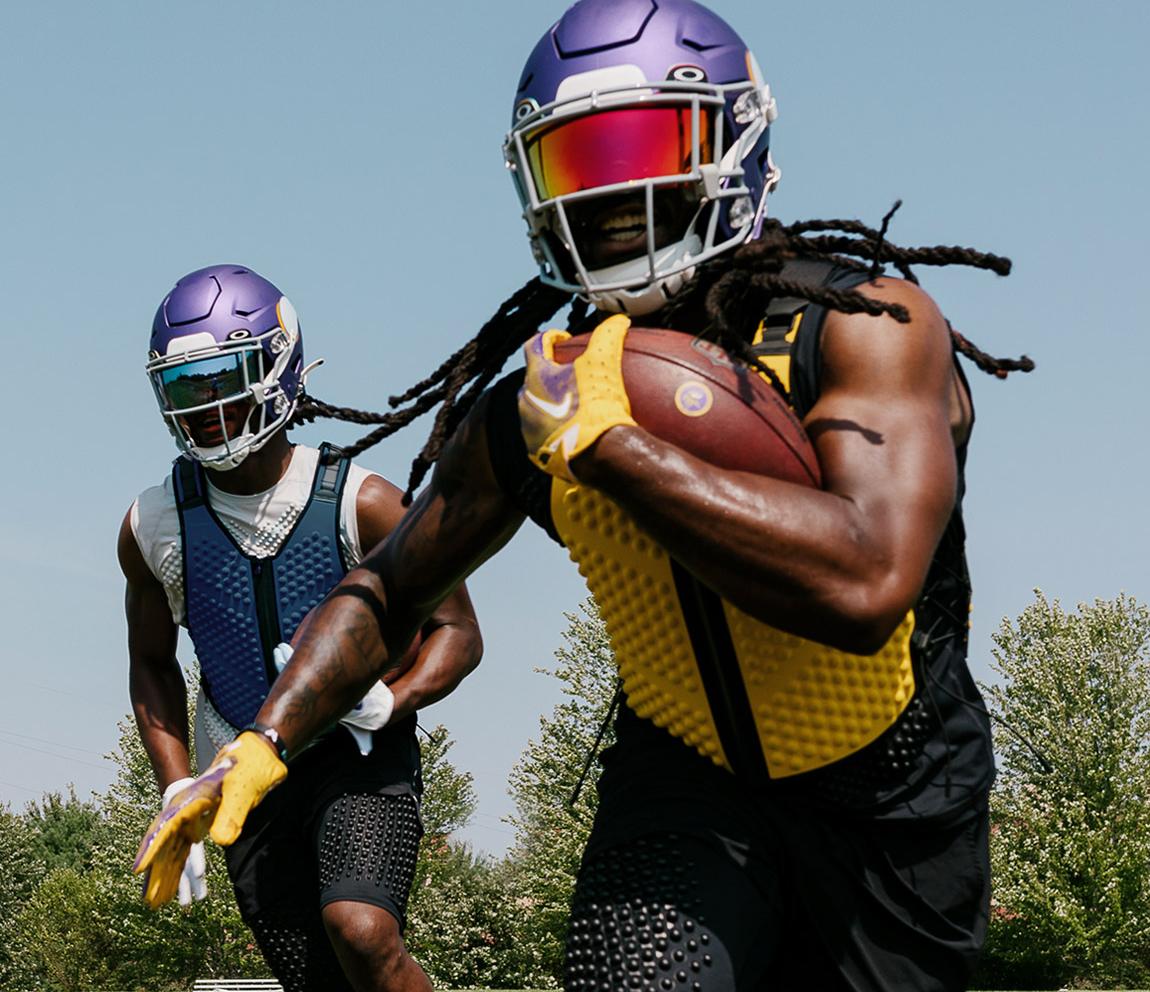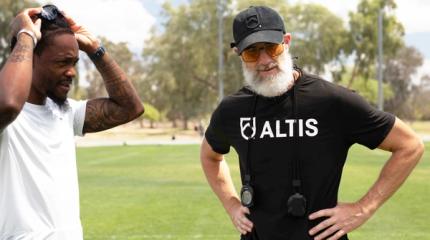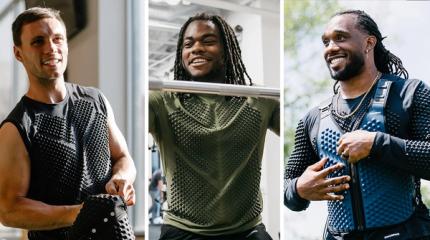For elite and aspiring athletes every rep, sprint, and drill matters during training. Backed by scientific research, wearable resistance such as OMORPHO’s G-Vest and G-Wear are tools that can transform training by enhancing speed, power, and resilience without compromising movement. At the core is the MicroLoad™ design, which evenly distributes small weights across the torso for a natural, unrestricted feel. Paired with OMORPHO’s full line of lightweight G-Wear, you can tailor your training to unlock peak performance. Whether you’re on the field, court, track, or in the gym, OMORPHO helps world-class athletes push their limits with science-based benefits.
Studies on wearable resistance have found measurable improvements in sprint acceleration, vertical jump height, endurance and power when athletes incorporate weighted vests into their routines. Here’s how, supported by peer-reviewed studies.
Improve Acceleration and Sprint Speed
Speed is one of the most valuable—and trainable—tools in an athlete’s arsenal. Whether you’re chasing down a breakaway, exploding off the line, or cutting through defenders, acceleration and quickness often separate good from great. That’s where wearable resistance, like the OMORPHO G-Vest, becomes a game-changer. A 2022 study published in the Journal of Strength and Conditioning Research found that soccer players who trained with weighted vests equivalent to 5–10% of their body weight saw a 3.1% improvement in sprint acceleration over just eight weeks[1]. That kind of progress can translate to sharper first steps, faster breakaways, and a greater ability to change pace during play. By subtly increasing resistance without altering form, OMORPHO can stimulate the fast-twitch muscle fibers responsible for explosive movement—helping you build real, repeatable speed under game-day conditions.
Greater Endurance
Endurance isn’t just about going longer—it’s about maintaining intensity when others start to fade. That’s where wearable resistance can give athletes a decisive edge. A 2019 study published in Sports Medicine found that training with weighted vests at 5–10% of an athlete’s body mass helped maintain higher blood lactate thresholds, which are a key indicator of fatigue resistance[2]. In simpler terms, athletes were able to sprint harder for longer before exhaustion set in. This is especially important in sports like soccer, basketball, or tennis, where repeated bursts of high-intensity effort are required over an extended period. By incorporating OMORPHO into training regimes athletes can condition their bodies to operate more efficiently under stress. The result? Greater stamina, improved recovery between sprints, and the ability to sustain peak performance deep into the game.
The G-Vest’s 5–10-lb load, aligned with these studies, supercharges your sprint training, helping you blaze past opponents on the track or field, while G-Wear can support lighter speed drills for variety.
Increased Vertical Jump Height
A higher vertical jump isn’t just impressive, it’s often the difference-maker in competition. Whether you're going up for a rebound, spiking a volleyball, or clearing the bar in track and field, explosive leg power can define the outcome. Research continues to show that training with wearable resistance can measurably improve lower-body force production and takeoff efficiency.
In a study published in the European Journal of Sport Science, athletes who trained with weighted vests saw a 8.7% increase in vertical jump height[3]. That kind of gain can shift an athlete’s ceiling, literally. Complementing that, a recent study in Scientific Reports found that the same load range increased ground reaction force by 4.2%, helping athletes generate more power from the floor and translate it into vertical lift[4]. By strategically adding resistance to training, the body adapts by recruiting more muscle fibers and improving neuromuscular coordination—leading to real, repeatable improvements in jump performance. For athletes looking to rise above the rest, wearable resistance offers a simple but powerful edge.
Unleash Explosive Power
The previously-mentioned Journal of Strength and Conditioning Research study also looked into the effects weighted vests have on power output[1]. The study showed a boost in explosive power by 9% in soccer players over eight weeks, enhancing jumps, sprints, and tackles[1]. Similarly, a 2019 case study in the Journal of Australian Strength and Conditioning showed that vests improved horizontal force production by 7.1%, cutting 40m sprint times by 2.4–3.4% over five weeks[5]. The takeaway? Strategic use of wearable resistance such as OMORPHO can stimulate neuromuscular adaptations that elevate performance when it matters most—on the field, on the court or track.
Enhance Recovery and Resilience
Beyond in-game performance, wearable resistance can help athletes stay fresh through a grueling season and training schedule. It’s been reported that weighted vest training can reduce post-training muscle soreness by 12%, supporting faster recovery[x] and improve blood lactate clearance, enabling quicker recovery from high-intensity efforts[x].
Why Elite Athletes Choose OMORPHO?
OMORPHO G-Vest is the ultimate training tool due to its form-fitting design featuring MicroLoad™. Unlike bulky alternatives, its breathable and adjustable design ensures comfort and precision during training for amateur and professional athletes. The science is clear: training with wearable resistance can unlock performance benefits, from faster sprints, enhanced endurance, higher jumps and quicker recovery.
- Bright, T. E., Hughes, J. D., Handford, M. J., Annis, B., Westwood, C., 2022, The Acute Effects of Weighted Vest Protocols on 20-Metre Sprint Performance in Youth Soccer Players
- Paul Macadam, John B Cronin, Erin H Feser, March 2022, Acute and longitudinal effects of weighted vest training on sprint-running performance: a systematic review
- Caleb R Marriner, John B Cronin , Paul Macadam, Adam Storey, October 2017, Redistributing Load Using Wearable Resistance During Power Clean Training Improves Athletic Performance
- Fabiano S. Fonseca, Bruna Daniella de V. Costa, Maria Elisa C. Ferreira, Santiago Paes, Dalton de Lima-Junior, Witalo Kassiano, Edilson S. Cyrino, Petrus Gantois, Leonardo S. Fortes, May 2020, Acute Effects of Equated Volume-Load Resistance Training Leading to Muscular Failure Versus Non-Failure on Neuromuscular Performance
- Paul Macadam, Sergi Nuell, TuronJohn, Cronin, Shelley Diewald, Jono Neville, April 2019, Thigh Positioned Wearable Resistance Improves 40 m Sprint Performance: A Longitudinal Single Case Design Study







